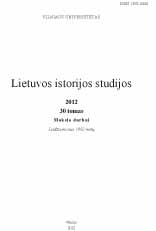LIETUVOS IR LENKIJOS KONFLIKTO PAAŠTRĖJIMAS 1927 METAIS: JÓZEFAS PIŁSUDSKIS KAIP TAUTININKŲ AUTORITARINĖS SANTVARKOS ĮTVIRTINIMO ĮRANKIS
The escalation of the conflict between Lithuania and Poland in 1927: using Józef Piłsudski as a tool for reinforcing the nationalist authoritarian re
Author(s): Vilma BukaitėSubject(s): History
Published by: Vilniaus Universiteto Leidykla
Summary/Abstract: As a result of the uprising in May 1926, Marshal Jozef Pilsudski became Head of the State of Poland. After the military coup d’état in 1926, Antanas Smetona became President of Lithuania, and Augustinas Voldemaras became Prime Minister and Minister of Foreign Affairs in December 1926. The new supreme government of Lithuania struggled with difficulties during the first years after the coup. Lithuania’s conflict with Poland, first ignited in 1919, worsened despite the continued conflict resolution efforts from the great European powers. The coup in Lithuania was organised by the left-wing political forces. Therefore, the new authoritarian government had to find ways to maintain the trust of the army and gain public support. The present article, written on the basis of the Lithuanian and French archives, the Lithuanian press and other sources as well as previous historical research, analyses the mechanism of the entrenchment of the authoritarian regime in Lithuania in 1927 and highlights the links between the domestic and foreign policy objectives pursued by the Voldemaras-led government. The Lithuanian society considered the lack of flexibility in its conflict with Poland to be a proof of its self-expression and principled foreign policy. At some international meetings before 1927, the Lithuanian Government even indicated to be at war with Poland. In 1927, Piłsudski, the de facto Head of State of Poland, noted that he perceived this indication as a permanent threat to his country. In the spring of 1927, President Smetona dissolved the Seimas and reshuffled the government. As a result, the leadership of the Lithuanian Nationalist Union, which previously had no influence in the country, became responsible for governing the nation. The government increased the army funding, raising its social profile and improving the living conditions of soldiers, and increased the number of military officers and privates. Between June and September 1927, President Smetona toured Lithuania, visiting even the smallest of towns. Resolving the foreign policy crisis proved to be the most difficult task. When the first results were expected after the mediation by France, the Lithuanian army officers demonstrated to the Prime Minister their discontent with the political concessions. Next, the League of Nations undertook to address the conflict, and on 10 December 1927 Pilsudski and Voldemaras confronted each other in Geneva. Voldemaras managed to transform the imminent agreement on the termination of war into a victory over the Polish Marshal, with France, Great Britain, Italy, Germany and the Soviet Union, probably for the first time after the First World War, being unanimous on a foreign policy issue of conflict resolution. The continued public trust in Voldemaras, as evidenced by the available sources, prompted the Prime Minister to abandon the idea of coalition government and led to the further strengthening of the authoritarian regime.
Journal: Lietuvos istorijos studijos
- Issue Year: 2012
- Issue No: 30
- Page Range: 117-128
- Page Count: 12
- Language: Lithuanian

